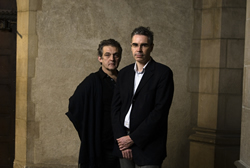Human sacrifices all around! Barbaric delights!
-- Bertolt Brecht, "A Short Organum for
the Theatre"
Why are we still so ready for Romeo and Juliet to die?
Simon Morrison, a musicologist, discovers
that Prokofiev's first version of his ballet includes a finale
in which the lovers survive; Mark Morris now stages the world
premiere of this version. And Alistair Macaulay, in the New
York Times, surely speaks for many when he rejects this version:
"And by giving us -- surprise! -- a happy ending, Mr. Morris clinches
how uninterested he is in telling any kind of story." Macaulay
writes as if the surprise were no surprise at all but the usual
infantile pandering, as if any story in which the lovers do not
die is no story at all, and as if it were Morris and not Prokofiev
who had contrived this divergence from Shakespearean writ.
Who does not share some scrap of Macaulay's
disdain? We have a kind of contemptuous pity for those eighteenth-century
fops and their Victorian descendants who could not bear to see
Cordelia die; now we can also disdain those modernists who needed
to let Romeo and Juliet dance on into some ethereal world after
this one.
Even a sketch of this particular modernist
tale is complex. (I draw all the following details from Morrison's
chronology in the wonderfully detailed program for Bard's Summerscape
festival--click
link.) Prokofiev writes the first version in consultation
with important Soviet collaborators; the new ending reflects a
political allegory in which transcendent youth overcomes feudal
stagnation. Prokofiev, a follower of Christian Science, is no
believer in death anyway. But in the mid 1930s, Soviet commissars
begin to crack down on more adventurous music and push for a cult
of the classics: by 1938, Prokofiev has completed the familiar
tragic ending. Later, in 1941, Prokofiev disowns the first version:
"The reasons for this bit of barbarism were purely choreographic:
living people can dance, the dying cannot." But maybe the barbarism
lies in this disowning of the happy ending?
Arrests of members of Prokofiev's circle
punctuate Morrison's chronology like obituaries. It should give
us pause when we find ourselves endorsing the Soviet enforcers
of aesthetic correctness. There is also no promise that simply
to reverse the judgment of the commissars will be satisfactory.
The situation was complex; it remains complex.
 Does
the final dance in Morris' ballet work? Responses will inevitably
vary as the production tours to several cities over the coming
year. I would say that it almost worked, and might well
work as the dance develops in time. Unlike Macaulay, I felt that
Morris had succeeded in choreographing the romance between the
lovers in earlier scenes (Maile Okamura and Noah Vinson, the Sunday
I saw the work). This Romeo and Juliet abandon themselves to each
other, and shut Verona out. Is it so terrible that Verona does
not kill them for it?
Does
the final dance in Morris' ballet work? Responses will inevitably
vary as the production tours to several cities over the coming
year. I would say that it almost worked, and might well
work as the dance develops in time. Unlike Macaulay, I felt that
Morris had succeeded in choreographing the romance between the
lovers in earlier scenes (Maile Okamura and Noah Vinson, the Sunday
I saw the work). This Romeo and Juliet abandon themselves to each
other, and shut Verona out. Is it so terrible that Verona does
not kill them for it?
Whether freak or revelation, Morrison unearthed
something fascinating in the career of Prokofiev, and in the reception
of Shakespeare. But what I am most concerned to note is how this
discovery illuminates one of the sometimes forgotten projects
of theatrical modernism. One strand of modernism came not to mourn
the death of tragedy, but to bury it, and to celebrate its death.
Tragedy seemed inextricable from the old regime; Marxists, in
particular, were suspicious of the glamour with which tragedy
graced unnecessary suffering. When Brecht criticizes the barbaric
entertainments of earlier tragedy, he has in mind its perpetuation
of a cult of violence and loss.
True, this rejection of tragedy can also
look like the building of Potemkin villages to defend against
finitude. It also contributed to some regrettable plays: Jonathan
Kalb aptly reminds me of Vishnevsky's Optimistic Tragedy
and other actually existing socialist anti-tragedies that give
one a whole new respect for plays in which people die cruelly.
The denial of death has provided cover for some unfathomably fatal
projects.
I, too, feel more comfortable when Romeo
and Juliet die as they should. Nevertheless, it came as a shock,
at once delightful and ringed with suspicion, to recall a historical
moment when it seemed necessary to imagine that they might not
have to die at all. The notion that that moment might live now
seems, yes, childish and barbaric, but few understand or can stage
such childishness and barbarism better than Morris. I wonder how
this happy ending will travel. I wonder whether, in time, it will
seem an urgent dance against the lazy celebration of tragedy or,
instead, another stratagem in the history of another culture in
crisis and in denial about its own complicity in mass death.
